Isfahan or “Nesf-e Jahan” as Iranians call it (which literally means “Half of the World”), is on every traveler’s must-visit list. The vote is in, Iranians and foreign tourists alike recommend traveling to Isfahan. Stuffed to the brim with historical attractions, breathtaking mosques, ancient bridges, Persian gardens, wild and windy bazaars, and ornate palaces, you can’t miss a trip to Isfahan.
Isfahan, which was once the capital of Iran, has more than its inner city sites. The deserts surrounding the city offer those tourists wanting a bit of adventure, an opportunity to explore. My itinerary includes attractions within the city limits, but if you have time, be sure to include a trip into the desert beyond.
I gotta say, three days is not enough to explore and unfold all the mysteries of beautiful Isfahan. Unfortunately, travellers are usually on a tight time frame so if you manage your time well, you can visit the most popular and famous sites in three days. Check out my recommendations here.
Day 1: Naqsh-e Jahan Square (Imam Mosque, Sheikh Lotfollah Mosque, Ali Qapu), Great Bazaar, Si-o-se Pol
Every tourist’s travel to Isfahan will definitely start with Naghsh-e Jahan Square, a name which is interwoven with the name of the city and contains an integral part of the city’s essence. The rectangular square is the second biggest square in the world, inscribed also as a UNESCO World Heritage site.
Exploring every corner of the square, it’s time to visit the historical building surrounding Imam or Naqsh-e Jahan Square on by one. The monuments belonging to Safavid Era (1501-1722) include Imam Mosque, Sheikh Lutfollah Mosque, and Ali Qapu Palace. Visit them one by one to see wonderful artworks on their ceilings and walls, grasp the life of Isfahanis living in the city over 300 years ago, working around the square in their small shops, closing them to participate in congregational prayer at noon in Imam Mosque and even imagining the shah meeting noble men in Ali Qapu Palace and watching Chogan (an Iranian polo game) played at the center of Naqsh-e Jahan from its terrace. Also, don’t miss the music room on the last floor of the palace. It’s, in fact, unfair to just have a glance on these masterpieces made in more than 10 years just in have a half day; it needs more than one day. you can book Isfahan hotels easily with 1stQuest.
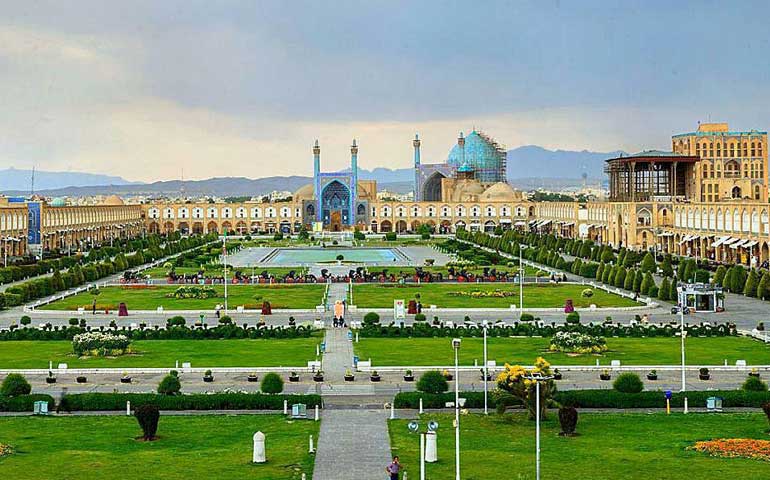
Naqshe-Jahan Square- Isfahan, Iran
Tips: don’t visit Naqsh-e Jahan Square in Ashura. Though you can visit the square itself, historical sites around it are closed in that time. Moreover, if you want to sit down in a corner for a while and admire the beauty of these buildings, may experience shows that Iranian New Year (Nowruz) is not a good time.
Then head to Qeysarie Bazaar or Isfahan’s Grand Bazaar, in the north of the square. However before getting yourself lost in the mazes of the bazaars and being mesmerized by the work of Isfahani craftsmen which some of them are still working in their small shops in bazaar, take a rest in Chah-e Haj Mirza or Azadegan Tee House, right outside of the Square.
The teahouse, decorated with old pieces of stuff and pictures, is most famous for its atmosphere and collections of antiques. Besides tea and food, you can also taste a special dessert, Dogh (a sour drink) and Goshfil (a kind of sweat), in the teahouse if you are a fan of contracting tastes; I am not a fan by the way. if you are looking for the best hotels check out this article: best hotels in Isfahan
By the time you finish wandering in the bazaar and probably buying souvenirs, I guess it is evening and time to visit Isfahan’s famous historical bridges especially Si-o-se Pol. Though the bridge is still beautiful in daylight, the adjacency of its 33lighted arches with the darkness of night and their reflection in the water of Zayandehrood makes an eye-catching view at night. Rambling on the bridge for a while and talking to enthusiastic locals, you may have the chance to join people gathered in its arches, singing and having fun.
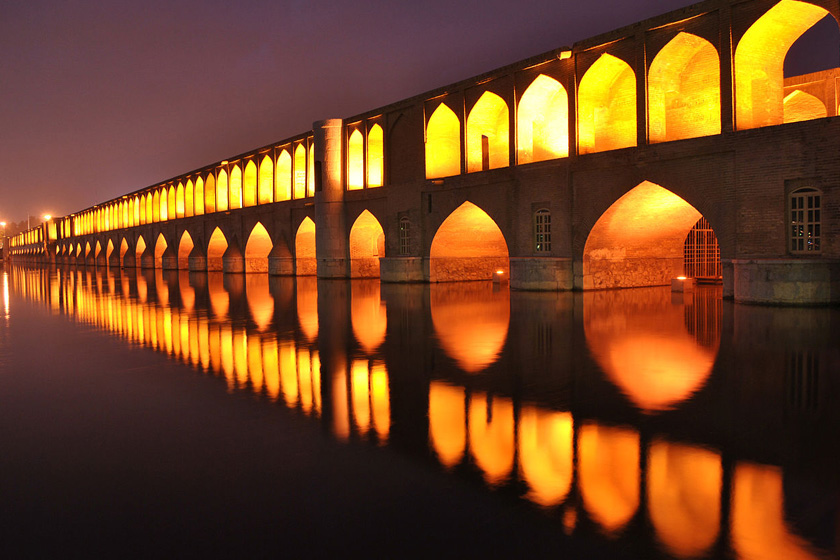
Si-o-Se-pol, Isfahan, Iran
My recommendation for dinner is Jarchibashi Restaurant, a renovated Iranian bathhouse which has been changed to a lovely restaurant serving delicious foods. You will definitely love its setting and decoration.
Day 2: Vank Cathedral, Isfahan Music Museum, Hasht Behesht Palace, Chehel Sotoun Palace
The second day of your Isfahan tour begins by strolling in Armenian Neighbourhood and visiting Vank Cathedral. The cathedral, built in 1664, is a subtle mixture of Armenian and Iranian architecture. Besides the cathedral, its eye-catching architecture and paintings, the complex has a museum and library containing valuable books and scripts.
The next site is not much old like other buildings we have visited so far but it is really worth visiting. From Vank Cathedral, walk south to Mehrdad Street, on the left side of the street, you will reach Isfahan Music Museum, a privately organized museum founded in 2015. What makes your visit to the museum memorable is not just the display of a wide range of musical instruments accompanied by a passionate guide but the live performance at the end. if you are interested in traditional hotels, check out this article: traditional hotels in Isfahan.
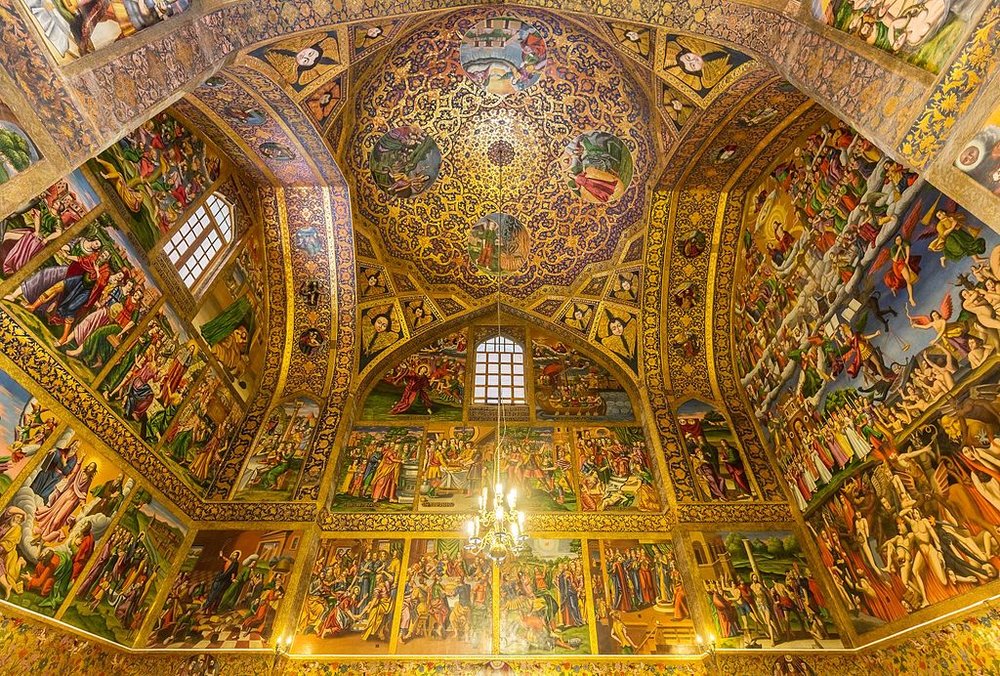
Vank Cathedral, Isfahan, Iran
Now, it’s time to visit what has been left from day 1 on the other side of the river. Not much far from Naqsh-e Jahan Square, you can find Chehel Sotoun Palace and its adjacent palace, Hasht Behesht. Chehel Sotoun which literary means forty columns is the other World Heritage Site of the city. The palace and its garden, once built for Shah for leisure as well as political purposes, is now an important historic site totally different from the ones around Naqsh-e Jahan Square and also the buildings in Jolfa, the Armenian Part of the city. The reception hall which is the most striking part of the palace is surrounded by walls depicting famous battles! Enjoy your time here.
In the vicinity of Chehel Sotoun, there is the other palace from Safavid Era. There is not much remained from the garden surrounding the palace, but the mansion itself is still a magnificent site to visit.
Conclude day 2 by eating dinner in the Abbasi Hotel, one of the oldest hotels not only among Isfahan hotels but also Iran hotels. First built as a caravanserai, the hotel’s courtyard is the perfect place to rest for a while and enjoy the architecture of the building as well as its ambiance. Besides the anterior which is like a museum with great mirror works, wall paintings, and antique decoration, you may even want to consider staying in one of its suites, each decorated after an important era of the country.
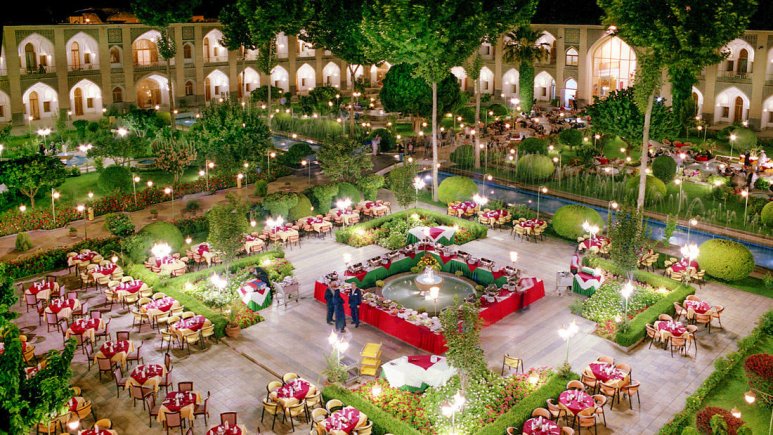
Abassi hotel, Isfahan, Iran
Day 3: Jameh Mosque of Isfahan, Menar Jonban, Atashgah Fire Temple
Begin your third day at Isfahan’s Jameh Mosque, the largest mosque of Iran which is still open for prayer and religious ceremonies. The mosque, built in the 8th century, was the main public place of the city in different eras. Wandering through its corridors and rooms, you can see traces of different monarchs all over the building.
No visit to Isfahan is complete without trying one of the traditional dishes of the city, Beryoon. Haaj Mahmoud’s Beryani, in walking distance of the mosque, serves the best beryooni of Isfahan. Give it a try! If you are looking for budget accommodation in Isfahan check out this article: Cheap Isfahan hotels.
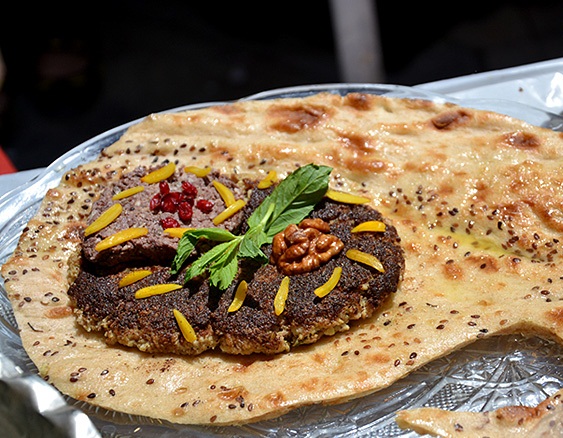
Beryani, Traditional food in Isfahan
Before going to the next historic place, I would recommend heading back to Naqsh-e Jahan Square and its Bazaars. Believe me, there are still much you haven’t seen at the square. You would discover new things every time you turn back to the square.
Visiting the holy places for Muslims and Armenians in the previous days, it is now the time to visit the remains of a Zoroastrian temple. Visiting the temple in the afternoon gives you the chance of seeing the city’s sunset in your last night in the city but considering that the temple is on a hilltop, be careful and have enough equipment’s.
On your way to the temple, you can also visit Seyed Mosque and Menar Jonaban. Menar Jonban is a historic building dating back to the 17th century with two shaking minarets. The minarets’ popularity comes from the fact that by shaking one of them, the other minaret would shake as well. Interesting, isn’t it? However, if you are not an architect or a great fan, I would not recommend visiting the monument.
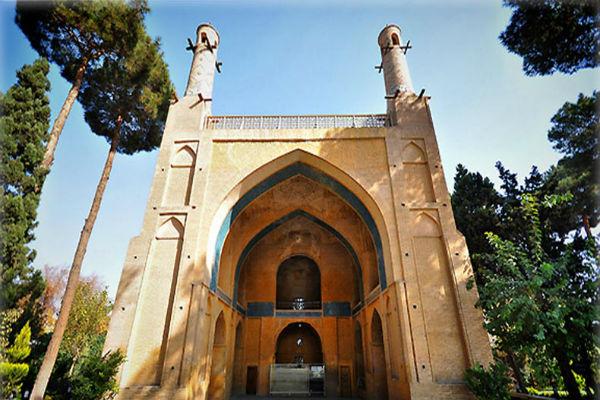
Menar Jonban, Isfahan, Iran
Tips:
If you are traveling with children, Isfahan Aquarium or the city’s Flower Garden are good options too.
To get the most out of your trip, it is better to have a guided tour of the city.


